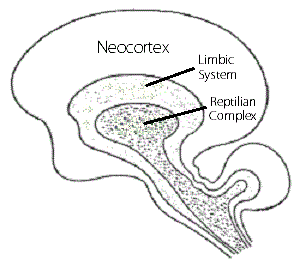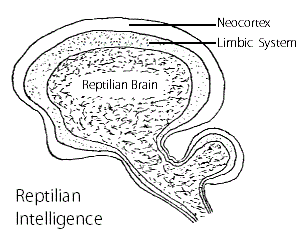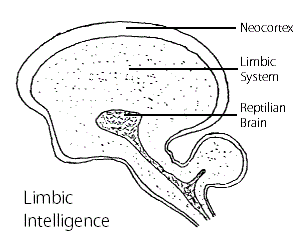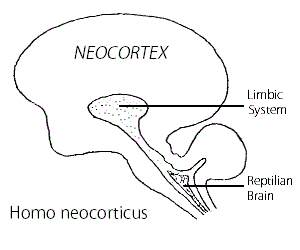© 1979 Robert A. Freitas Jr.
All Rights Reserved
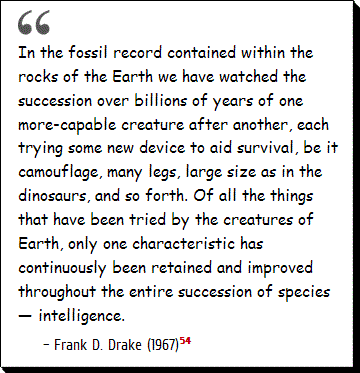 |
In Chapter 3 we suggested that there are basically two distinct ways of viewing the question of intelligence.
- First, there are the "structural" approaches which attempt to define intellect in terms of specific physical characteristics of neural equipment — brain mass, neurological complexity, and so forth.
- These were briefly discussed in that earlier chapter, and were found to be somewhat useful in comparing relative intelligence levels among the fauna of a single world (Earth).
But structural definitions are suspect in xenobiology because they tend to restrict the universe of discourse.
- While we hope that we have at least a vague notion of what intelligence does or ought to do, there may be many physiological — structural — ways of building a biological unit to do the same job.
- For this reason, probably the majority of xenobiologists would favor a functional definition of intelligence over a merely structural one.
- This would appear to be the only way to avoid the peculiarities and limitations of the mental organs found on Earth.
What is the best way to set forth a functional definition of sentience? Some writers have advocated a "checklist" approach.
The suspect creature should be carefully observed, they urge, and watched for signs of a specific constellation of behaviors from which smartness can be inferred.
Typical list items include:
- Faculty of reason
- Ability to fashion and use tools
- Proficiency with language
- Predisposition to learn from experience, or "mental plasticity"
- Forethought and equilibration
- Creativity, insight, and intuition
- Ability to transmit culture
- Sociability
- Use of logic
- Ability to symbol
- Curiosity
- Ability to perceive spatial, temporal, numerical, or abstract relationships
- Imagery and the ability to construct perceptual worlds
- Memory
- Self-awareness or consciousness
Such definitions, while perhaps adequately circumscribing the bounds of human intelligence (and this is questionable), actually tell us little about the nature of intellect as a general force in nature. Checklists tend to be anthropomorphic, culture-limited and starkly geocentric, and as such afford no real insight into the possible character of alien intelligence elsewhere in the Galaxy.
A somewhat more generalized intellect-defining behavioral hierarchy has been suggested by the well-known Harvard University entomologist Dr. Edward O. Wilson. He divides evolved intelligences into three distinct levels:
- Lowest grade — the complete instinct-reflex machine. Representative organisms (sponges, coelenterates, flatworms on Earth) are so simply constructed that they must depend largely or wholly on token stimuli from the environment to guide them.
- Middle grade — the directed learner. These organisms (arthropods, cephalopods, cold-blooded vertebrates and birds) have a fully elaborated nervous system with some programming, some learning. Typically it is narrow in scope and limited in responsiveness to a narrow range of stimuli. It results in behavior as stereotyped as the most neurally programmed "instincts."
- Highest grade — the generalized learner. These organisms (humans, primates, social canids) carry a wide variety of memories, some of which have only a very low probability of ever proving useful. Insight learning may be performed, yielding the capacity to generalize from one pattern to another and to juxtapose patterns in ways that are adaptively useful. Few if any complex behaviors are wholly preprogrammed morphogenetically at the neural level. Perception of history, in the broadest sense, is a key feature.565
Wilson’s system provides an evolutionary progression, a standard against which extraterrestrials might theoretically be measured. Yet this definition — rather, identification — of intelligence suffers from many of the same weaknesses of the checklist approach. The fundamentals of thinking simply are not addressed.
Roger A. MacGowan, an aerospace computer scientist formerly at the Redstone Arsenal in Alabama, recognized that the key to understanding alien intelligence lies in data processing.729 The thinking process, he notes, consists of an arbitrary number of information-processing functions which may be carried out by living creatures. MacGowan selected five criteria which he believed to be both necessary and sufficient to specify intellectual functioning in any life-form in the universe:
- Input — An organism must be capable of reacting to physical events occurring in its environment. If it has no sensory input, it has no information to process and thus cannot think.
- Storage — Without the ability to remember, a creature could not learn. All data processing would have to proceed in real time, with full throughput and no delays. Such a being would perceive no past or future, merely an ever-present now. Since the primary function of life is to accumulate information and structure, it is hard to see how a creature without memory could possess an adaptive and useful intellect without recollection of the past.
- Deduction — The ability to compare current input information patterns with stored information patterns is a crucial intellective function. By making such an association, the creature becomes able to respond to the present on the basis of its past. The ability to use the generalizations formulated yesterday to respond to the problems of today is of great selective value in the struggle for survival.
- Induction — Inductive thinking must be considered a prerequisite for thinking, because it provides "a means of altering stored information patterns as a function of each input information pattern in such a way as to form or modify generalizations on the basis of experience." With induction, an organism is able to respond to its future on the basis of its past.
- Output — After it has decided what to do, an intelligent being must act. This output may manifest itself either as physical or mental activity.
MacGowan’s criteria for intelligence, if we accept them at face value, are probably sufficient for the purposes of the First Contact Team. Yet they provide more identification than explanation of what intelligence does. Our search is not quite ended, but we sense that we are on the right track.
|
It is easy to view intelligence, on the one hand,
as a kind of speeded-up evolution of sensory data, or to view natural evolution, on the other hand, as a "painstaking and slow, but implacable, intelligence." Life is a negentropic process that extracts order from ■ How much alive is determined by how complex ■ Life is properly defined along a spectrum — Similarly, intelligence is a negentropic process ■ Again, we claim, the greater the data flow ■ Intelligence, like life, cannot be defined in |
It is interesting to note that the processes of intelligence are remarkably similar to those of life itself. The methods used by brains to collect and order environmental information recapitulate the methods used by natural evolution.
To perform the functions suggested by MacGowan, for instance, brains or nervous systems must collect data, filter and reject irrelevancies, store and process that which is relevant, and then arrive at some conclusion based on the input stimuli.
- The techniques of natural selection are quite similar.
- Thousands, millions, or even billions of organisms — the "data bits" of evolution — are "fed" into the environment.
- There they are shuffled, ordered, discarded and selected according to fitness — that is, they are "processed" through the environment.
- The species as a whole picks up information thereby and collectively "learns" how to survive, storing the hard-won data in the community gene pool.
It is easy to view intelligence, on the one hand, as a kind of speeded-up evolution of sensory data, or to view natural evolution, on the other hand, as a "painstaking and slow, but implacable, intelligence."1000
| Negentropic process |
Life is a negentropic process that extracts order from the environment and stores it in a complex structure. How much alive is determined by how complex the structure is. Life is properly defined along a spectrum — the greater the data, the more alive the lifeform. Similarly, intelligence is a negentropic process by which information is extracted from the sensory data stream generated by stimuli in the environment. Again, we claim, the greater the data flow the smarter the lifeform. Intelligence, like life, cannot be defined in a yes/no manner but must be viewed in terms of a spectrum of functionality.
|
Intelligence, indeed,
seems as inevitable as life itself. |
Even primitive protozoans have rudimentary neural apparatuses, and can be trained to do simple tasks such as swim up glass capillary tubes and cling to sterile platinum wires. More advanced creatures such as earthworms and snails are easily trained to perform more complicated "tricks." We find the glimmerings of higher intelligence in the most modest of Earth’s inhabitants, a striking example of evolutionary convergence on a grand scale which should provide some clue as to its ubiquity on other worlds.
Intelligence, indeed, seems as inevitable as life itself.3241
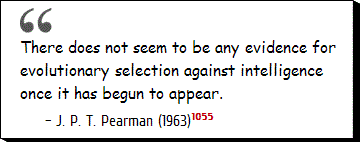 |
We may perhaps glean some insight into the evolutionary processes underlying the emergence of intelligence by examining how human intellect arose on Earth.*
- While details may differ from planet to planet, the outcome of mental evolution elsewhere in the universe should be at least functionally similar.
* What is the optimum body shape for sentient ETs? Scientific opinion remains sharply divided on this question, and two schools of thought have emerged. The pro-humanoid camp (including Bieri,1706 Blumrich,1058 Campbell,1380 de Camp,2572 Fletcher,1935 Howells,330 Hynek,597 Ley,212 MacGowan,600 Ordway,2571 Puccetti,71 Rall,445 and Spall1137) claims that the primate form is best for tool-using aliens.
|
What is the optimum body shape for sentient ETs? Click for Synopsis
|
The non-humanoid camp (see Blum,1668 Broms,1191 Clarke,81 Dobzhansky,1705 Eiseley,135 Huygens,602 Muller,1184 Oparin,1558 Ornstein,327 Ruzic,559 Sagan,85 Shapley,1554 Simpson,334 Vertregt,1171 and Wald867) holds that the human form is a unique evolutionary accident that will not be repeated elsewhere. (There is also a middle-of-the-road camp, such as Anderson,63 Gardner,1555 and Molton,1129 but this is a minor faction.) The debate has raged for decades, and will not be detailed here. Suffice it to say that the humanoid form is a very useful one, so it probably will not be rare. Whether it will be common remains an open question.
| Most primitive microorganism |
The amoeba is one of the most primitive microorganisms on Earth today. In its own limited environment, it does quite well without any nervous system. The amoeba responds to chemical gradients and bits of food floating by, towards which it extends its pseudopods, engulfs, and consumes.
| More sophistication with crude memory |
Another protozoan — the paramecium — is vastly more sophisticated by comparison. This animal is covered with a kind of "fur," a coating of tiny hairlike cilia growing from the outer wall of the single cell. As paramecia move through the water the tiny cilia beat in unison, coordinated by small filaments connecting the roots of the hairs. Each organism also has a ciliated mouth so that food may be fanned into the microscopic gullet.
While it has only the simplest of nervous systems, the paramecium does have a crude "memory." For instance, when it bumps into an obstacle, it has the ability to back up, turn slightly to one side, and move forward again. It can thus remember whether what it did last was wrong, and If so, it can correct the situation.
| Colony of single-celled creatures |
The sponge exemplifies the next stage in the evolution of multicellular intelligence on Earth. This organism is really just a colony of single-celled creatures with abilities similar to those displayed by paramecia. The hundred or so individuals in the collective manage to beat their cilia in the same general direction, thus setting up a flow of water and food for the benefit of all.
But there is no whole-body coordination — a stimulus applied to one part of the animal causes only a local disturbance close to the site of application. Cells farther away are never informed of the problem, and do not react.
| Global coordination |
The hydra is probably the simplest terrestrial creature alive today with what is called "global coordination." If there is some noxious stimuli, the entire organism will bend away. It has a rudimentary "true" nervous system which permits impulses to traverse the entire body. But there is no brain, so the hydra is incapable of very sophisticated responses. It cannot pool a variety of stimuli, and it cannot really choose among alternative actions.
The development of early life, from simple reactivity in the amoeba to full global coordination in the hydra, seems fairly straightforward. If the Hypothesis of Mediocrity holds true and Earth is typically exotic, the evolution of whole-body coordination may be expected to be basically similar on other worlds.
|
The ganglionic system ■ The invertebrates, representing perhaps 97% of all ■ Information is processed fast enough and in sufficient If this is no measure of biological success, what is? |
But above the level of Hydra, evolutionary convergence begins to break down.
- According to the paleontological record, there is a fork in the road.
- The animal kingdom divides into two distinct classes representing wholly different stratagems for gaining increased intelligence.
| First stratagem: Ganglionic nervous system |
Nearly a million animal species — arthropods, molluscs, and many other invertebrates — opted for what paleoneurologists call the "ganglionic" nervous system. The earthworm is typical. Each of its many segments is almost an individual organism unto itself — each having its own set of kidneys, muscles, sensors and so forth. Coordination is achieved by a thin latticework of nerve fibers crisscrossing the animal from side to side and lengthwise.
The ganglionic system resembles, more than anything else, a ladder with bulbous neural ganglia at each of the joints. The invertebrate organism thus is comprised of a collection of sub-brains, each of which controls a separate part of the animal with fairly complete autonomy. The organizational structure is not unlike that of a political confederation.
|
The ganglionic system (details) Click for Synopsis
|
Sensors tend to cluster nearer the head. A brain of sorts — enlarged ganglia — accumulates there, but it isn’t a true brain as we understand the term. Perhaps it is better described as merely a large collection or bundle of separate ganglia. Nevertheless, such a nervous system proves to be highly efficient for getting quick response to stimuli. Each clump of nerve cells becomes "expert" as some particular function — detecting and passing along sensory information, sweeping leg or wing in wide uniform arcs, opening and closing the jaws in slow munching motions during feeding, and so on. The entire system is orchestrated by "consultation" with the "chairmanship" of the bundle of ganglia concentrated in the head, but there is no real centralized control.
The ganglionic system has proved an enormous success on Earth. The invertebrates, representing perhaps 97% of all animal species alive today, have discovered a data processing technique adequate to ensure their survival. Information is processed fast enough and in sufficient quantities to enable ganglionic organisms to thrive and proliferate. If this is no measure of biological success, what is?
|
Why virtually no improvement in the design? Click for Synopsis
|
Might extraterrestrials develop extremely high intelligence using a ganglionic nervous system, by far the most common on this planet?
The chances are strongly against it.
Half an eon ago the invertebrates ruled the Earth. Huge trilobites crawled the shores, gigantic dragonflies with impressive wingspans patrolled the skies, and monstrous squids plied the oceans with little competition. But since that time, in all the hundreds of millions of years that have followed this period of early dominance, there has been virtually no improvement in the design. Why?
Evolutionary biologists have suggested several answers which are interesting from a xenobiological point of view. First, it is believed that the system simply is too complicated when it is scaled up in size. With more and more units, ganglia become inefficient, unwieldy, and bureaucratic. While invertebrates tend to be restricted to smaller sizes for unrelated technical reasons, it’s even true that large invertebrates of greater mass than vertebrates are not nearly as intelligent. For example, many lobsters are larger than squirrels, and many squids are vastly bigger than most vertebrates — and yet these ganglionic creatures invariably are stupider kilogram for kilogram. The system itself appears to be at fault.
It has also been suggested that the ganglionic system is self-limiting. Typical invertebrate structure has only enough room to accommodate programmed "hard-wired" behavior, with no space left over for surplus neural matter that might eventually evolve and enlarge into higher intellect. Still another factor is that the endless cross-connections within the body can become so entangled and interwoven that they actually begin to strangle other body organs. A case in point in the spider, whose head ganglia happen to ring its gullet. But they have grown so massive that they squeeze the throat very tightly, and the poor animal can only swallow its food in a thin trickle.
|
If one deftly clips off the abdomen of a feeding wasp,
the head may go on sucking, obviously not distressed. The mind of such a creature must be alien to us almost beyond comprehension. |
It is hard for us to imagine the mentality of beings with ganglic intelligence. Dr. H. Chandler Elliot, Professor of Neurology at the University of Nebraska College of Medicine, describes the peculiar disconnectedness of the world-view of the invertebrates:
We humans usually disregard our internal organs: We suffer discomfort from an empty stomach, and we heed a stomach’s demands for relief of indigestion, but normally we disregard its activities. The head of an insect apparently regards not only its viscera but also its legs, wings, and so on, with similar detachment: If one deftly clips off the abdomen of a feeding wasp, the head may go on sucking, obviously not distressed. The mind of such a creature must be alien to us almost beyond comprehension.90
|
As we shall see presently, this "central nervous system"
is probably the intelligence of choice for sentient extraterrestrials even though it represents only a tiny percentage of all living animal species on Earth. |
We come at last to the second distinct stratagem for achieving intelligence. A long time ago, a small band of daring organisms set out to explore a totally new system of neurological organization. The chordates (vertebrates plus a few others), who even today number only in the tens of thousands of species, began to experiment with "neural monarchy." As we shall see presently, this "central nervous system" is probably the intelligence of choice for sentient extraterrestrials even though it represents only a tiny percentage of all living animal species on Earth.
| The flatworm |
The flatworm (Planaria) was perhaps the earliest organism to advance beyond the simple nerve net of the hydra. With its primitive central nervous system, the flatworm can actually combine different types of stimuli and then act on this processed information. The animal has two eyespots, a pair of photosensitive cups which give it a curious cross-eyed look. Depending on which side is brighter, the flatworm wriggles away, for it fears the light. Olfactory sensors spread over the surface of its body can sense the smell of rotting meat — a repast the flatworm heartily enjoys — and off he goes in the direction of the scent. If contradictory input is received (the smell of rotten meat under a bright light) the organism is able to decide whether dinner is worth braving the intervening glare.
| The lancelet |
|
Figure 14.1 The Rise of the Brain in Terrestrial Biological Evolution |
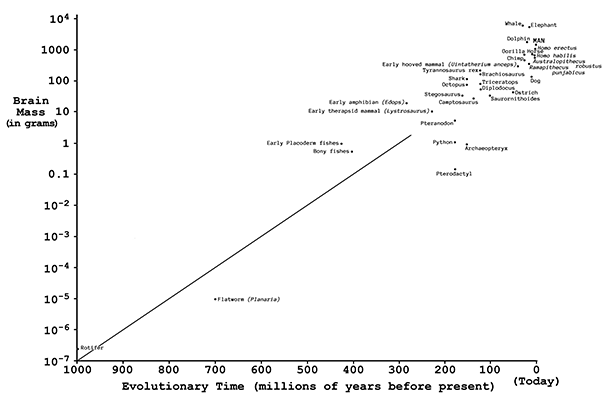 |
One of the first true chordates probably was the ancestor of the modern lancelet (Amphioxus), a small wormlike aquatic mud-dweller. Amphioxus takes the global coordination of hydra and the deductive ability of the flatworm and packs it all into a neat, centralized neural tube. Under dissection there appears to be little difference between brain and spinal cord. But the distinction is of fundamental significance.
The lancelet’s central nervous cord is vastly simpler than the ladder-like ganglionic system of the earthworm. Any number of additional sensory, analytical, or information-processing units may be plugged into the "central data bus." With this simple invention organisms could evolve to any size, yet continue to increase their intelligence simply by plugging in more "peripherals." The spinal column could grow into something far more massive than ganglionic nerve nets, yet never entangle or choke off other organs of the body. The simple brain was more compact and had plenty of room in which to expand. Over millions of years, it began to grow (Figure 14.1).
Dr. Elliot explains the evolutionary significance of this invention in the development of intelligence on Earth:
Thus our worm-fish ancestor could learn. As an individual, of course, he must have been an unteachable dolt, compared to whom a bee is a gifted scholar. But as a race, he and his descendants steadily added new resources to their bodies and brains for ages during which the bee was interminably repeating its perfected, dead-end patterns of living. Till finally creatures arose that could learn freely as individuals — squirrels, cats, and men, who can expand their unified minds farther in an hour than a bee in all its year or two of life, and for many thousands of hours. Man, above all, aspires to worlds and universes of power and delight eternally closed to the bee. All this he owes to the original neural tube, simple but overwhelmingly more potent than the highest facile, flashy, self-limiting ganglionic system.90
|
Many comparative neurophysiologists now
believe, the ganglionic or "distributed brain" is the wrong path for higher intelligence |
If, as many comparative neurophysiologists now believe, the ganglionic or "distributed brain" is the wrong path for higher intelligence, then it is virtually certain that a great many extraterrestrial races in our Galaxy will have made the same momentous discovery during their long evolutionary trek. If ETs have discovered other alternatives to the ganglia and the central notochord, well and good. They would be fascinating to observe, because they would be without precedent on Earth. But we know that the path of the chordates is a sound one, and this is why we expect the idea of notochords and brains to be familiar to alien xenologists as well.
|
It must be borne in mind that evolution is Once something novel has been invented, The new is built upon the old, but does not |
Even assuming that evolution on this world has selected the optimum basic configuration for neural components in the development of intelligence, we cannot expect the specifics of brain development elsewhere to exactly parallel our own. Yet it is fascinating to consider how much of what we are today has been dictated by our neuroevolutionary past.
Among chordates, the most ancient component of the central nervous system is the plug-in spinal cord. As noted above, all sorts of interesting subsystems and advanced modifications could be hooked on as the organism grew in size and complexity. But it must be borne in mind that evolution is a tendentious, almost bureaucratic, process. Once something novel has been invented, it's generally retained and not thrown away. The new is built upon the old, but does not replace it.
| Triune brain / neural chassis |
Dr. Paul MacLean, chief of the Laboratory of Brain Evolution and Behavior at the National Institute of Mental Health, believes that this is exactly how the human brain evolved over the years.2559 His theory of the "triune brain" is one of the most xenologically important developments in our understanding of the emergence of human intelligence. This theory, which neuroanatomists agree is a gross oversimplification of reality, nevertheless provides real in sight into the nature and potential diversity of alien minds.
MacLean begins by pointing out that the simplest fishes have small add-on lumps of neural cells which comprise its limited brain. These lumps are in two sections which biologists call the brain stem and the midbrain. The brain stem and midbrain, together with the spinal notochord common to all chordates, are probably the minimum amount of equipment necessary to operate any vertebrate larger than a small fish. MacLean groups together these three components and calls them the "neural chassis."
|
Figure 14.2 The Triune Brain in Humans, and Possible Alien Alternatives |
|||||
|
Figure 14.2A
A highly schematic representation of the reptilian complex, Figure 14.2B
Possible Alien Triune Brain Figure 14.2C
Possible Alien Triune Brain Figure 14.2D
Possible Alien Triune Brain |
The scientist believes that the story of man’s brain involves the slow accretion, over evolutionary timescales, of three successive and overlapping brain structures that were plugged in to the neural chassis, modular-style — but which were never removed once nature was through with them. Following each evolutionary step, the older more primitive modules were left in place and new ones plugged in on top of them (Figure 14.2).
The human triune brain, explains MacLean, "amounts to three interconnected biological computers, each with its own special intelligence, its own subjectivity, its own sense of time and space, its own memory, motor, and other functions."2559 Each represents a major new evolutionary step. Because the present human brain has this peculiar tripartite structure, and since each of the primitive components is still present and operational, "we are obligated to look at ourselves and the world through the eyes of three quite different mentalities."
| Reptilian brain |
The earliest of the three human plug-in brain systems has been called the "reptilian brain." This structure surrounds the midbrain in the neural chassis and probably arose 300 million years ago with the rise of the first reptiles.
| Limbic brain |
The second unit was laid over the first, eventually taking over the higher organismic functions. This unit is called the "limbic brain," and probably arose about 150-200 million years ago with the emergence of the first mammals on Earth.
| Neocortex |
The third and final unit, which appears in most of the higher mammals, is the neocortex. This structure began to develop about 30 million years ago as a small growth on top of the limbic system, slowly spreading, enlarging, becoming more massive over time, finally reaching the peak of accelerated development a few million years ago with the rise of man. The neocortex now completely encases the underlying layers of reptilian and limbic brain. It is more central to neurological control functions in humans than the other two systems.
Each of these brains has a different way of looking at the world. Each has a different mode of operation. And yet each is functioning still within our heads, causing untoward psychological conflict and, as we shall see, much of what is interesting about human behavior.
|
The reptilian mind is not characterized by
powerful passions and wrenching contradictions, but rather by a dutiful and stolid acquiescence to whatever behavior its genes and brains dictate. |
The reptilian brain, for example, is now known to play a major role in determining aggressive behavior, territoriality, ritualism, and the establishment of social hierarchies.2552 This dull, plodding neurosystem, with its slavish dependence on programmed "hard-wired" behaviors, may be responsible for a great deal of human ritualistic and hierarchical behavioral patterns:
- our political institutions and bureaucracies
- our fertility dances
- our unparalleled aggressiveness and competitiveness
The reptilian mind is not characterized by "powerful passions and wrenching contradictions, but rather by a dutiful and stolid acquiescence to whatever behavior its genes and brains dictate."2552
| Endocrine glandular system |
The limbic system, which overlays the reptilian brain, appears to generate strong, vivid emotions of various kinds. This is the seat of the endocrine glandular system, which is governed by the pituitary or "master gland." The amygdala, a subsidiary gland, is known to regulate aspects of fear, aggression, and attack behavior. Hormones released into the bloodstream by the hypothalamus and thalamus control such diverse functions as hunger and thirst, attention span and anxiety, and visual retention.
|
There are reasons to suspect that the
beginnings of individual altruism, neonatal and parental care, even love may have followed the development of the limbic system in the evolving mammalian brain. |
The oldest part of the limbic brain is the olfactory cortex, which does for smell what the higher auditory and visual centers do for sound and light. The hippocampus, another limbic structure, is believed to control a wide variety of mental functions including:
- short-term memory
- sensitivity to pain
- sexual interest
There are reasons to suspect that the beginnings of individual altruism, neonatal and parental care, even love may have followed the development of the limbic system in the evolving mammalian brain.2552
The neocortex, home of the higher human cognitive functions, represents perhaps 85% of the entire brain volume in man. As mammals evolved this gigantic "tumor" swelled outward like a balloon, increasing the cranial volume — and intelligence — markedly.
The neocortical brain carries on a wide variety of highly sophisticated data processing functions.
- The frontal lobes are concerned with deliberation, initiative and caution, anticipation and planning, and overall regulation of complex behaviors.
- The parietal lobes handle spatial perception, three-dimensional orientation, and the exchange of information between the brain and the rest of the body. They also provide the ability to manipulate symbols which is so crucial to the development and use of language.
- The temporal lobes contain the auditory centers were acoustical data is monitored, processed, and rerouted.
- The occipital lobes are charged with processing visual information coming from the eyes.
What do xenobiologists have to say about all of this? It is not unreasonable to suppose that alien evolutionary patterns may also include some form of neural chassis with plug-in components. Certainly this is an adaptive course of development that encourages survival. But it is asking too much of evolutionary convergence to expect that natural selection on other planets will produce exactly the same neural chassis structural overlays as our own. ETs might have only two higher brain systems, or four, instead of our basic three. And the distribution of behavioral functions and memory subsystems will likely be vastly different.
|
It has been suggested that
one prerequisite for neocortical development is a stable internal body temperature — that is, homeothermy or warm-bloodedness. |
Nevertheless, and purely as an hypothetical exercise, let us examine the kinds of alien minds we might encounter elsewhere if the three major stages of vertebrate mental development on Earth (ritual, emotional, and reasoning) prove to be more or less universal.
| Homeothermy (warm-bloodedness) |
It has been suggested that one prerequisite for neocortical development is a stable internal body temperature — that is, homeothermy or warm-bloodedness.85 This hypothesis receives at least tentative confirmation by the appearance of both limbic and neocortical systems only after the rise of the warm-blooded mammals. On a world where homeothermy was never invented, the reptilian complex might eventually come to dominate the brain of sentient extraterrestrials.
Dinosaurs, bearers of the largest of the reptilian brains, are traditionally regarded as extremely dumb animals. Typical is Diplodocus, a monstrous beast weighing twelve metric tons and guided by a tiny brain the size of a golf ball.The dinosaurs ruled the Earth for a hundred million years, yet their brains advanced little during that time.
Still, we must take care to avoid "mammal chauvinism." In point of fact, there were a few dinosaur species that were slowly evolving towards higher intelligence using the reptilian brain. One good example is the species Saurornithoides, whose members weighed in at 50 kilograms with brains of about 50 grams. These small reptiles were bipedal, with four-fingered hands and an ability to catch and eat small mammals. Their intelligence has been compared to that of the modern ostrich.
| High alien reptilian intellect |
On another world, given enough time and a slower introduction of homeothermy, might high alien reptilian intellects emerge? (Figure 14.2b) Sentient creatures in whom the R-brain dominated the others might have learned to hunt collectively and perhaps prevent the proliferation of mammals at a later date. The psychology of such creatures would be a fascinating blend of ritual and peculiar species-specific responses, and their dogged aggressiveness and unyielding devotion to duty could make them quite fearsome warriors.
Most of the mammals on Earth did quite well with only a limbic brain perched atop the ancient reptilian complex. Perhaps the neocortex isn’t necessary for higher intellect at all. What if conditions on another world were such that the limbic brain (Figure 14.2c), rather than the neocortex, came to represent the highest level of brain development? How could this state of affairs ever come about?
|
It is a fact that the olfactory cortex takes up
a considerable portion of the limbic brain. whom scent is the primary sensory modality, such as dogs, the olfactory cortex is far more intricate and elaborated than it is in man. |
Xenobiologists recognize that the limbic component of the mammalian brain is very closely connected with the sense of smell. It is a fact that the olfactory cortex takes up a considerable portion of the limbic brain. It’s also known that in those animals for whom scent is the primary sensory modality, such as dogs, the olfactory cortex is far more intricate and elaborated than it is in man.
In the previous chapter we suggested various environments which may tend to favor the evolution of beings who rely more heavily on olfactory, rather than visual or auditory, stimuli. These same environments, given enough time, should also tend to favor the enlargement and articulation of the olfactory centers in the limbic system which no subsequent neocortical development could ever hope to match. In other words, osmic aliens will have brains designed to handle olfactory data, which in turn implies the evolution of high limbic intelligence.
Sentience which is predominantly limbic will be more subject to emotional distractions than other forms of intellect. These extraterrestrials may be unduly concerned with ameliorating hunger, thirst, and other "creature comforts" of life. They might also be inordinately preoccupied with sex, even by the most libidinous human standards.
We see that diverse forms of alien intelligence can be imagined, simply by allowing that extraterrestrial brains may be dominated by reptilian or limbic, rather than neocortical, components. But even if ETs are predominantly neocortical, this is no guarantee that their minds will be equivalent to ours.
| Perpetually inclement world |
Reptilian creatures first appeared during the Mesozoic era on Earth, a period in our planet’s history marked by a very mild, warm, uniform climate on a global scale. Mammals didn’t take over until, so to speak, the weather turned from fair to foul. Let us imagine a world which is perpetually inclement, varying widely from hot to cold and dry to wet without respite. On such a planet, there might be significant advantage in developing homeothermy far sooner than on Earth.
If warm-bloodedness arrived early enough, perhaps even predating the rise of cold-blooded or reptilian creatures, then the rapid unfolding of biological evolution could leave the reptilian component of the brain relatively small and insignificant. ETs might have few traces of the R-complex, a few scant shards of the limbic system, and would possess brains comprised primarily of neocortical material.
These aliens would think far differently from humans, even though they share with us a large neocortical component. The ancient drives of aggression, dominance, and impulsive hierarchical organization might be wholly foreign to them, and they could have great difficulty fathoming the significance of our many cultural rituals and our religious and political institutions. To them, our emotionality would appear primitive, even barbaric.
|
While intelligence arises because lifeforms
must adapt to their environment, it will continue to evolve only so long as the adaptation is not perfect. Higher intellect leads either to greater survivability or to superior control of the environment, either of which in turn lead to a decrease in the need to develop still greater intelligence. |
Along similar lines, Doris and David Jonas point out that while intelligence arises because lifeforms must adapt to their environment, it will continue to evolve only so long as the adaptation is not perfect.1000 Higher intellect leads either to greater survivability or to superior control of the environment, either of which in turn lead to a decrease in the need to develop still greater intelligence.
In the last 30 million years of terrestrial history, the neocortex of mammals has enlarged from a mere wisp to a massive structure dominating the human cranial cavity. The Jonases hypothesize that this trend will continue, because human society is not yet perfectly adapted to the technological environment it has created. The ability to comprehend and analyze increasingly complex and abstract problems is of greater selective value than ever before. The knee-jerk emotional reactions radiated by the limbic system appear maladaptive in a society in which rationality is the hallmark of success. And the ritualistic and aggressive behaviors caused by the reptilian brain seem incompatible with a healthy, undogmatic, liberal culture on a small planet with limited resources and finite territories.
| Homo neocorticus |
So it is not unreasonable to suppose that the neocortex may continue to enlarge with the passage of future human generations. Perhaps it will eventually grow to replace most or all of the cognitive and behavioral functions presently assumed by other brain systems. The resulting intelligence, which the Jonases feel may be in the cards for humanity, may be called Homo neocorticus (Figure 14.2d).
Like the ancient alien homeotherms described above, extraterrestrials whose culture is highly technologically oriented may undergo similar evolution, slowly casting off their primitive drives one by one as they become highly rational and unflappable thinkers.
|
Then there is the possibility of Homo bionicus,
with his snap-on input monitors, his plug-in memory modules, and his subcutaneous microcomputer logic circuits. |
It could be that the timescales in such projections are all wrong. Millions of years were required even for the abnormally rapid expansion of the human neocortex, whereas social and technical changes require time periods on the order of tens, hundreds, or thousands of years.
| Homo bionicus |
However, it is unlikely that the ultimate evolution of Homo neocorticus or his extraterrestrial counterpart is impossible. The very rapidity of technological processes may permit a kind of artificial evolution to an equivalent state. Advanced genetic engineering, for example, could make possible the design and development of altered humans with reduced or restricted limbic and reptilian brain components. Artificial biological brain components or bioneered modules could be used to replace ancient brain sections with more advanced neocortex-like structures. Then there is the possibility of Homo bionicus, with his snap-on input monitors, his plug-in memory modules, and his subcutaneous microcomputer logic circuits. Each of these are reasonable models of conceivable alien intelligences with whom we may someday have to learn to deal.
|
Figure 14.3 Information Stored in Genes, Brains, and Cultures |
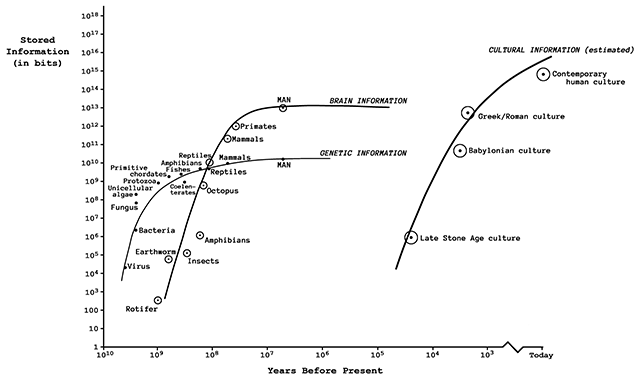 |
| Biological information storage |
Any organism that must sense its environment and react to it, or seek mates and reproduce, or hunt for prey and avoid being preyed upon; or which has some form of locomotion or mobility probably will discover that added intelligence is of enormous benefit and selective value. In the game of life, smarter animals generally do better than dumber animals. Certainly one of the most interesting questions from the standpoint of xenology is: Will extraterrestrials have "advanced" intellect?
To the extent that intelligence is data processing, the more information a creature and process and store the smarter it is and the more competitive it will be in the struggle for survival on its home world during its natural evolutionary phase. The fundamental unit of information is the "bit," or binary digit, briefly discussed in the previous chapter in connection with sensory apparatuses. A bit, in the parlance of information theorists, is the amount of information needed to correctly choose between two equally likely answers to a simple yes/no query.
| Twenty Questions |
Let’s take an example. The English alphabet has 26 letters. If you play "Twenty Questions" with a friend who has some single letter in mind, it’s possible to guess which one it is by asking as few as five independent yes/no questions. (Try it.) Thus, theorists argue that a printed letter represents exactly five bits of information. The average five-letter word therefore has 5 × 5 = 25 bits, and so forth.
Figure 14.3 is a map of the various forms of biological information storage found on planet Earth. There are three curves, defining a clear progression from lower to higher capacity.
|
We can imagine three distinct ways in which
the quality of intellect may be worked out in biology. We shall call these "genetic sentience," "brain sentience," and "communal sentience," three steps along the path of ever-increasing intelligence. |
| Data stored in genes |
The lowest curve represents the amount of data stored in the genes of terrestrial organisms. Judging from its antiquity, genetic information storage appears to be the slowest, most time-consuming means available to living creatures. On timescales of millions of years, changes in the information stored per genome are imperceptible. Evolution evidently is a very slow intelligence.
| Data stored in brains |
The middle curve shows the storage of data in the brains of animals. This is a much faster process — large changes are readily apparent over time-scales of millions of years. The number of bits stored per entity, as well as the complexity of behavior, is greater with brains than with genes. Still, on timescales of millennia there is little change in the maximum quantity of information capable of being stored by a single biological brain.
| Data stored in human cultures |
The highest curve at the far right displays the amount of data stored in human cultures as a function of time. Sociocultural bit-storage is at once the most volatile and the most efficient technique, representing another quantum leap in overall capability. Change is rapid on timescales of millennia, and long ago surpassed the levels of the other two curves. In a sense, social evolution may be viewed as an extremely fast intelligence.
From these three curves, we may define three distinct orders of possible "advanced" alien sentience. Accepting tentatively the speculation that level of intelligence may depend in part upon the ability of an organism to assimilate information, we can imagine three distinct ways in which the quality of intellect may be worked out in biology. We shall call these "genetic sentience," "brain sentience," and "communal sentience," three steps along the path of ever-increasing intelligence.
 |
| Group intelligence |
Imagine an alien species which for some reason is trapped at the level of genetic information storage. Unable to progress to more efficient forms with higher data ceilings, the intellect of each individual entity is limited to what can be done with genes alone.
The insects of Earth are a case in point. It will be recalled that the majority of the animal world consists of invertebrates without notochords. instead, a network of smaller sub-brains called ganglia is used. The main brain in the head is merely a larger-than-normal aggregation of ganglia, so the basic system appears to be self-limiting as regards maximum size and complexity.
| Information stored in genes |
Finding the road to bigger brains — the next step up in intelligence — blocked, a few clever insects decided to make do with what little they had. Unable to become better at coping with the environment by individual intellectual effort, the social insect species (ants, bees, termites, etc.) reworked their genetic structures in order to increase their adaptability. Instead of storing information in their limited brains alone, they stored it in their genes. Their DNA, rather than their individual minds, learned.
| Social insects |
Can we really say that the social insects are sentient, though? There is nothing wrong with this at all. If one considers the anthill or the beehive as a single superorganism — as do several xenobiologists565 — each clearly displays many of the attributes of higher intelligence:
- Data from the immediate environment are absorbed and acted upon.
- Judgments are made almost exclusively at the community level as regards:
- • foraging for food
- • reproductive activity
- • temperature and humidity control in hive or hill
- • military defense of the colony and so forth
|
Ants respond strongly to pheromone (smell) signals,
and bees to visual cues (e.g., the waggle dance). or electrical* modes to achieve community-wide information processing and control. |
And if sentience requires an ability to recognize the self, the social insect superorganism clearly meets this test.
- Colonies of ants or bees are acutely aware of their own identity.
- Individuals have no difficulty recognizing members of foreign colonies (even of the same species) as strangers.
In this sense, each nest is aware of itself as an entity or living system distinct from all others.
Many variations on this theme may readily be imagined from the vantage point of the xenological perspective. ETs with genetic sentience (often called “group intelligence”) may achieve communication between individual units in a wide variety of different ways. Ants respond strongly to pheromone (smell) signals, and bees to visual cues (e.g., the waggle dance). Aliens might choose auditory, tactile, magnetic or electrical* modes to achieve community-wide information processing and control.
| Intelligent scum |
Radioastronomer Ronald Bracewell has proposed a slime-mold colony with genetic sentience, which he disparagingly refers to as an "intelligent scum."80 But there is no reason why individual members of societies with genetic sentience need be small and insignificant creatures, There may be valid evolutionary pathways that lead to genetic overspecialization before an advanced, self-aware brain can gain a foothold.
|
The result of such evolution might be a society
of genetically distinct breeds within the main species, each specialized to perform specific societal functions — farming, construction, administration, recordation, soldiering — and each possessing a fairly complex technologically- capable mind without individual sentience. |
The result of such evolution might be a society of genetically distinct breeds within the main species, each specialized to perform specific societal functions — farming, construction, administration, recordation, soldiering — and each possessing a fairly complex technologically-capable mind without individual sentience. At least one modern psychological theorist has claimed that it is possible to think, calculate, and build complex technical civilizations without the capacity for individual self-awareness.2599
Science fiction writers Larry Niven and Jerry Pournelle created such an alien race in The Mote in God’s Eye.668 The extraterrestrial creatures in this novel had a diversity of different castes, determined genetically, for specialized forms of labor. The society was highly technological, despite the superficial resemblance to a termite colony, and was capable of radio, nuclear fusion, and interplanetary travel. Individual self-awareness, while apparently possessed by a few castes on a limited basis, was not the norm.
Genetic sentience and high technology, then, are not necessarily mutually incompatible.
* In Olaf Stapledon’s excellent science fiction novel Last and First Men,2567 the author describes the evolution of sentience among a collection of biological components which he calls “virus types." What appears to he a mere cloud of particles on the surface of Mars is actually a diffuse mass of physically separated units, whose intelligence arises through the integration of the whole by means of an electrical information transmission capability in the larger aggregates. The radio signals used by the human astronauts scramble the aliens’ "mind," precipitating an outbreak of hostilities. Dr. Thomas Gold also has suggested the possibility of a society of “electric ants” with “group intelligence” and immortal consciousness.22
 |
|
The brain sentient ET
is aware of itself as a unique being different from all others. |
| Unique from all others |
Genetic sentience involves a community of organisms that is aware of itself, but whose members are not individually aware. For such lifeforms, automatic behaviors and duty are all. To a social insect, each of its neighbors are virtually indistinguishable and fully interchangeable (within each caste or age grade). There is no sense of individuality; there is no word for "I." And with no sense of self there can be no sense of empathy for the selves of others — their thoughts, their drives, or their pain.
The brain sentient ET is aware of itself as a unique being different from all others. In the higher lifeforms, many subtle and complex clues are used to distinguish each of perhaps thousands of other local members of the species from the self. These distinctions are achieved without the penalty of genetic overspecialization. Much societal information is not "hard-wired" as in the social insects but rather is learned during childhood and possesses a flexible, or "plastic," nature.
- The lowest brain-toting creatures on Earth, such as fishes and amphibians, seem incapable of telling their own offspring apart from members of physically similar species which are their prey (the kids are eaten at birth if the parents happen to be hungry).
|
Genetic sentience involves a community
of organisms that is aware of itself, but whose members are not individually aware. and duty are all. virtually indistinguishable and fully interchangeable. |
- Reptiles improve on this somewhat.2566
- However, it is mainly among the birds and the mammals — the two animal groups with the most highly evolved brains on this planet — that familial and social ties begin to be taken seriously.
- Many birds are known to have complicated pecking orders with dozens of independently identifiable animals in the chain.
- Among primates, particularly the chimpanzees, orangutans, and, of course, humans, xenologists find a developing or well-developed sense of the self2563 as well as a complex awareness of the individuality of others.
Possible variants of brain sentience, involving the concept of the triune brain. have already been discussed in an earlier section.
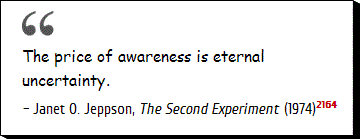 |
|
Communal sentience is difficult for ■ Just as insects can only be dimly aware of the implications of their tiny brains, ■ We humans can only vaguely appreciate the plethora of historical forces and sociocultural processes which circumscribe our social existence. |
|
To them, humanity would appear ■ Our continual relapses into states of war ■ Our dependence on elaborate, formalized and highly specialized institutions ■ Our lack of empathy with others would seem pitiful and barbaric. |
| Internalized sociocultural awareness |
Cultural information storage is clearly the most efficient and well-integrated technique available to biological lifeforms. As the graph indicates, it represents as great an improvement over brain-dependent systems as the brain represents over genetic systems. Sentience based on an internalized sociocultural awareness must be equally advanced beyond our own.3329
| Genetic sentience |
Beings with genetic sentience are physiological and social specialists.
- Both body and mind are strictly "mission-oriented."
- Individual initiative is stifled and behavior is stereotyped.
| Brain sentience |
Brain sentient individuals have cast off the shackles of biological specialization.
- Members of these species are more or less physiologically generalized.
- Such creatures, of which humans are a typical example, are nevertheless forced to retain their social specialization patterns — pecking orders, dominance hierarchies, governments, etc.
| Communal sentience |
Extraterrestrial species that have achieved communal sentience will be both physiological and social generalists.
- Not only will physical form be roughly equivalent throughout the society, but each individual member will be capable of handling virtually all sociocultural tasks with ease.
- While the individual members of a genetically sentient group are totally unconscious, and brain sentient humans are aware of themselves but not of their society, communal sentient aliens will have a well-developed, very real sense of their community as well as of themselves.
- Individuality need not be sacrificed: A new level of awareness is simply tacked onto the old.
- Somehow — perhaps by electronic telepathy or psychological synchronization — each creature can sense what is good for society just as a human knows that it is good to eat when he is hungry or to scratch when he itches.
- The alien feels personal anguish at offenses against the community, and perhaps even views it as a real, physical extension of his own body.
One wonders what such a race might think of us. To them, humanity would appear at best partially conscious. Our continual relapses into states of war, our dependence on elaborate, formalized and highly specialized institutions, and our lack of empathy with others would seem pitiful and barbaric. Just as humans can train a dog to perform certain useful tasks for purposes incomprehensible to the animal itself, perhaps communal ETs could teach us a few sociopolitical "tricks" to enable us to live together in harmony — though we understand them not at all.
The distinctions between the communal and genetic modes of sentience should perhaps be made more explicit. In a differentiated genetic society, the individuals are physically different from members of other castes and perform only very specialized physical and social tasks. In comparison, the communal society consists of individuals with similar bodies (no castes) and who perform highly generalized physical and social tasks. In the former, the individual member has no self-awareness whatsoever; in the latter, the individual has a deep and abiding (almost visceral) understanding both of his own self and of the corporeality of his society.
Communal sentience is difficult for human beings to imagine. Just as insects can only be dimly aware of the implications of their tiny brains, we humans can only vaguely appreciate the plethora of historical forces and sociocultural processes which circumscribe our social existence. The idea that alien beings may exist who can sense the pulse, the hunger and the mood of their community as easily as we can of our physical bodies is a mysterious and alluring possibility.
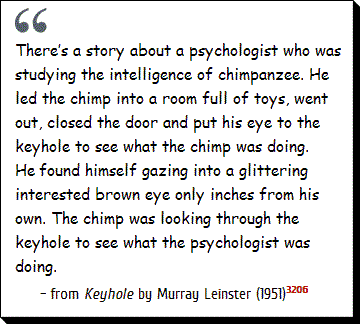 |
|
Despite several millennia of avid
theorizing, philosophers, theologians and psychologists still cannot agree exactly what consciousness is. |
At last we arrive at the fascinating question of alien consciousness — whether it exists, what form it may take, and how advanced it may be. From our awareness of our own consciousness, we suspect it may be the most significant and unique aspect of the human thinking apparatus. Will ETs be conscious too?
Despite several millennia of avid theorizing, philosophers, theologians and psychologists still cannot agree exactly what consciousness is.
- The standard dictionary definition is fairly popular:
"Consciousness is the awareness of one’s self as a thinking being." - (Indeed it has been argued by some that the emergence of self-awareness represented the true dawn of humanity.2564)
- Other definitions abound, ranging from "awareness of awareness" to mere "wakefulness" or alertness.
According to Dr. Julian Jaynes, a Princeton University psychologist, most people feel that consciousness is the most self-evident thing imaginable about the human psyche:
We feel it is the defining attribute of all our waking states, our moods and affections, our memories, our thoughts, attentions, and volitions. We feel comfortably certain that consciousness is the basis of concepts, of learning and reasoning, of thought and judgment, and that it is so because it records and stores our experiences as they happen, allowing us to retrospect on them and learn from them at will.2599
|
Thinking, judgment, verbal association, deductive
and inductive reasoning, intuition, creativity and abstraction all do not require consciousness in order to be displayed by an intelligent lifeform. |
Unfortunately, most if not all of these statements may be false. Consciousness does not appear to be a copy of experience, storing up experience, copying it like a camera to be reflected upon at some future time. Rather, suggests Jaynes, "conscious retrospection is the retrieval of what you have been conscious of before, and the reworking of these elements into rational or plausible patterns." Consciousness is not necessary for conceptualization either. One of the great functions of language, Jaynes says, is "to let the word stand for a concept, which is exactly what we do in writing or speaking about conceptual material, {which} we must do because concepts are usually not in consciousness at all." Similarly consciousness seems unnecessary for learning, which snails and flatworms can do. In fact thinking, judgment, verbal association, deductive and inductive reasoning, intuition, creativity and abstraction all do not require consciousness in order to be displayed by an intelligent lifeform. Concludes Jaynes:
Consciousness is a much smaller part of our mental life than we are conscious of, because we cannot be conscious of what we are not conscious of. How simple that is to say; how difficult to appreciate! It is like asking a flashlight in a dark room to search around for something that does not have any light shining upon it. The flash light, since there is light in whatever direction it turns, would have to conclude that there is light everywhere. And so consciousness can seem to pervade all mentality when actually it does not. … Consciousness does not make all that much difference to a lot of our activities. If our reasonings have been correct, it is perfectly possible that there could have existed a race of men who spoke, judged, reasoned, solved problems, indeed did most of the things that we do, but who were not conscious at all.2599
|
More complex living systems at higher levels of
organization manifest characteristics, more than the sum of the characteristics of the units which comprise them, not observed at lower levels. |
Consciousness, much like intelligence itself, appears to be an example of what is called an "emergent" by evolutionary theorists. According to Dr. James Grier Miller, President of the University of Louisville and a pioneer in systems science, more complex living systems at higher levels of organization manifest characteristics, more than the sum of the characteristics of the units which comprise them, not observed at lower levels.3071 These new characteristics are emergents, made possible by the increased complexity present in higher-level systems. Dr. A.G. Cairns-Smith, Professor of Chemistry at the University of Glasgow in Scotland, describes emergents from the standpoint of biological evolution:
One can see natural selection as conserving and improving biological machinery. But this is far from the whole story: sometimes a quite new function is discovered, or some new way of performing an old one. Maynard Smith3303 has discussed how this can happen. He says: "This is a very common feature of evolution: a new structure evolves first because it confers advantage by performing one function, but in time it reaches a threshold beyond which it can effectively perform a different function." Lungs seem to have arisen through such a threshold, through fish finding another use for the esophagus — as an auxiliary respiratory organ. This set in train a series of modifications that was to lead, eventually, to the exclusive respiratory organs of animals. The "improving" aspect of selection was an essential part of the story, but lungs are not improved gills, they did not evolve through a succession of design modifications from gills. Lungs took over.
Objects often turn out to have uses other than that for which they were originally designed: headlamps are signals, books are flower presses, and so on. Indeed often a machine may be curiously well adapted to an inadvertent function, or a material developed for one purpose be found to have diverse uses. We might say that bone is stiff for load bearing functions, but this property was to be important too, in connection with efficient sound transmission, during the evolution of the mammalian ear. For higher evolution generally, such function ambivalence has not been simply an odd side effect. It has been part of normal strategy. Above all it has provided means of escape from initial design approaches.3302
Miller offers another clear-cut example of emergents by comparing three different electronic systems:
One of these — a wire connecting the poles of a battery — can only conduct electricity, which heats the wire. Add several tubes, condensers, resistors, and controls, and the new system can become a radio, capable of receiving sound messages. Add dozens of other components, including a picture tube and several more controls, and the system becomes a television set, which can receive sound and a picture. And this is not just more of the same. The third system has emergent capabilities the second system did not have, emergent from its special design of much greater complexity, just as the second has capabilities the first lacked.3071
|
A number of scientists today suspect that
the phenomenon of consciousness may be an emergent arising naturally from the organizational complexity and processing efficiency found in the human brain. |
How does all this relate to consciousness? A number of scientists today suspect that the phenomenon of consciousness may be an emergent arising naturally from the organizational complexity and processing efficiency found in the human brain. Neurobiologists recently have delved more deeply into the workings of the brain, and many have concluded that a general physiological theory of human consciousness soon may be possible. Dr. Gerald M. Edelman, Nobel. prize-winning immunologist from Rockefeller University in New York, has made a tentative step in this direction.3005 At a 1977 meeting of more than a hundred neuroscience researchers in Colorado, Edelman outlined his theory.2562
| Primary brain repertoire |
The human thinking organ, he claims, is not infinitely malleable as previously supposed. Instead, there are a large number of different kinds of neural circuits hardwired into the brain. These respond to input from each of the senses like a tuning fork stimulated with resonant vibrations. The hardwired circuit groups consist of aggregates of from 50 to 10,000 individual neurons (the human brain has a total of about 10 billion), and together comprise the "primary brain repertoire."
| Secondary brain repertoire |
According to Edelman’s theory, the primary repertoire responds when the message to which it is susceptible is received. Such receipt causes the neuron group to emit its own signal, which is recognized in turn by a second level of neural groups called the "secondary brain repertoire." The secondary level equipment, presumably since it receives greater amounts of compounded and pooled data, lies at a deeper level of awareness than the primary sensory hookups.
Consciousness arises when impulses and patterns generated by the secondary repertoire are cycled around and fed back in as fresh input for other units in the secondary repertoire. While the primary system only responds to direct sensory data from the outside, the secondary system can also respond to internally-generated data as if it were externally-generated. This self-monitoring effect, according to Dr. Edelman, gives rise to human consciousness because it allows a review of internal states. In other words, the brain can watch itself work.
| Levels of awareness |
Science fiction writers are fond of pointing out that there may exist many different levels of awareness among the extraterrestrial races of our Galaxy.1543 Perhaps the most classic example of this may be found in The Black Cloud, written by astronomer Fred Hoyle.62 In the novel it is suggested that natural grades of consciousness may exist, and that it is virtually impossible for a being at one level to comprehend the mentality of another being at a higher level of consciousness. In a similar vein, Carl Sagan draws a fanciful analogy from our relation to the insect world:
The manifestations of very advanced civilizations may not be in the least apparent to a society as backward as we, any more than an ant performing his anty labors by the side of a suburban swimming pool has a profound sense of the presence of a superior technical civilization all around him.15
These writers may not be far of the mark, for it appears quite possible that a variety of different grades of awareness may emerge at successively higher levels of organization and processing capability. Why is this so?
|
The essential characteristic of all intelligent
systems constructed of matter-energy is that they process information. |
The essential characteristic of all intelligent systems constructed of matter-energy is that they process information. As noted earlier, smarter lifeforms tend to survive more often than dumber ones, so we should observe a strong evolutionary trend toward increasing intellect. Translating this into the language of information theory, we might say that the more bits per second a given creature can process, generally the more successful it will be and the stronger the evolutionary pressure to increase the bit rates that brains can handle. Furthermore, since more efficient organisms preferentially survive, all else being equal, there should also exist strong evolutionary tendencies to increase the efficiency of information processing — that is, to process more information using less energy and less material supportive bulk.
| Figure of merit |
If these notions are basically sound, then xenologists may define a "figure of merit" applicable to all sentiences in the universe, one which expresses both capacity and efficiency in a single number. This we shall call the Sentience Quotient (SQ). It is expressed. as the log10 of the quotient of two numbers: The maximum bit rate a sentient creature can process per unit time interval (in bits/second), divided by the quantity of mass-energy the entity needs to do it (in kilograms).
What is the theoretical maximum SQ of any thinking entity in the universe? While this question may at first appear intractable, actually it is not. According to H.J. Bremermann, if energy levels are used as information markers (the most efficient markers imaginable) then the theoretical maximum amount of information that can be processed by a totally dedicated lump of matter is 1.4 × 1050 bits/sec-kg.3072 (See further discussion in Section 25.2.2.) An alien being capable of handling data this rapidly would have to be considered a "perfectly efficient" thinker. In any given mass category, such an entity would possess the greatest intelligence theoretically possible in this universe. Hence, the highest SQ is about log10(1.4 x 1050) ~ 50.
|
That is, there may exist a number of
higher-order intellectual emergents, analogous to but qualitatively vastly superior to consciousness. |
| Natural order of awarenesses |
Consider, as a purely speculative hypothesis, that there may exist a natural order of awarenesses in the cosmos. At each higher level of mentality, a new kind of thought process emerges which is unique to mental systems of equal or higher values of SQ. That is, there may exist a number of higher-order intellectual emergents, analogous to but qualitatively vastly superior to consciousness.
|
Table 14.1 Universal Scale of Sentient Emergents |
 |
What might these higher-order emergents be? The author’s own speculations are offered in Table 14.1. According to this scheme, the most primitive emergent of intelligence is simple "reactivity" — the differentiation of body cells into specialized cells whose sole function is data processing. Perhaps this requires a minimum of 1 bit/sec-kg in the most primitive organisms.
Consciousness of the human type is the next highest emergent. Human brains have about 1010 neurons with about 103 interconnections each and a bit rate on the order of 103 bits/sec/neuron.3071 But brains have tremendous redundancy; assuming a redundancy of 1:104 and a body mass of about 100 kilograms, the human organism works out to about 1010 bits/sec-kg,3233 or SQ ~ 10. This seems near the minimum for the emergence of consciousness.
| Mental classes |
Taking similar steps of ten orders of magnitude for each new emergent to appear, at least four successively more sophisticated mental classes should exist above the level of ordinary human consciousness.
- The first of these is "communality," or the emergent of communal sentience discussed earlier in this chapter (14.2.3 Communal Sentience), perhaps at the 1020 bits/sec-kg level.
- Second could be "hypersociality," a yet higher order of mentality capable of internalizing the processes, functions, and interrelationships between many different societies and species of sentient beings (1030 bits/sec-kg).
- Third might be "galacticity," a single creature’s comprehension of the complexities of a galactic community (1040 bits/sec-kg).
- Finally there could be "universality," the ability of a single sentient entity to hold in its mind the seemingly incalculably complex orderings of an entire universe – full of living systems at all levels of intellectual sophistication (1050 bits/sec-kg).
Naturally, at each higher level of data processing fewer data may be processed at that level. For instance, human consciousness can only handle in formation at about 0.1-1.0 bits/sec-kg,3071 even though our brains may be able to process reactivity (nonconscious) data at much higher rates. Note also that a conscious brain-based entity such as a human can only process communal-level data at the rate of 10-10 bits/sec-kg (because communality has not yet emerged), which perhaps helps to explain why humans have such great difficulty comprehending the intricate workings of the societies in which they live. Finally, note that an intelligent entity at any one level should also possess all simpler levels of awareness as well. Thus for example an hypersocial sentient ought to have communality and consciousness as well as simple reactivity.
Further implications of the Sentience Quotient concept in "first contact" situations are explored in greater detail in Section 25.3.
